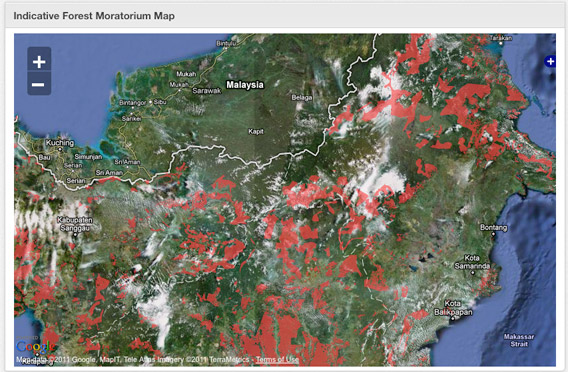
Researchers have launched a new tool to help policy-makers, NGOs, and landowners evaluate the potential benefits and costs of Indonesia’s reducing emissions from deforestation and degradation (REDD+) program at provincial and district levels.
The REDD calculator, developed by Lian Pin Koh of ETH Zurich, Holly K. Gibbs of the University of Wisconsin-Madison, and Peter Potapov and Matthew Hansen of South Dakota State University, generates emissions reductions estimates and associated opportunity costs for different REDD+ implementation scenarios, including Indonesia’s two-year moratorium on new logging concessions in primary forest and peatland areas.
“The tool basically allows anyone to explore how an indicative forest map might look under various scenarios,” Koh told mongabay.com via email. “It also calculates the carbon and opportunity cost implications.”
The REDD calculator includes a mapping function, which displays areas in Kalimantan protected under the moratorium.
“The coolest feature of this tool is the ability to produce, on-the-fly, an indicative map of forest moratorium areas based on user-specified moratorium scenarios,” Koh added. “By raising public awareness of the opportunities and costs of implementing the moratorium, this tool can help inform future discussions and debates concerning future REDD+ strategies in Indonesia.”
The REDD calculator is built on several layers of data including plantation and concession information from the World Resources Institute, Sekala, and the Ministry of Forestry of Indonesia; satellite imagery from NASA’s Moderate Resolution Imaging Spectroradiometer (MODIS), NASA Landsat, and the Daichi-Advanced Land Observing Satellite (ALOS); and field estimates of carbon stocks.
Projections
The REDD calculator produces some interesting results. Plugging in data based on not unreasonable assumptions, the authors find that a moratorium that includes only primary forests (like that signed this past May) would protect around 9.1 million hectares of land and 7.1 billion tons of carbon across Indonesian Borneo. Including secondary forests would more than double the area protected, but carbon stocks would only increase to 9.7 billion tons, a result of secondary forests’ lower carbon storage. But the cost of expanding the moratorium to include secondary would be substantial, boosting the opportunity cost from $132 billion to $226 billion over the 25-year time frame. Under this scenario, the model implies an opportunity cost of $5.08 per ton of carbon dioxide for a moratorium limited to primary forests and an opportunity cost of $6.35 per ton of carbon dioxide for a moratorium that includes secondary forests.
The authors conclude that while their effort has limitations “due primarily to data availability and quality”, it offers users a valuable tool in REDD+ analysis.
“Nevertheless, we reiterate that the main utility of our application is that it allows users to specify model scenario and alter model assumptions according to the best and most current data available to them,” they write. “We argue that this in and of itself is a valuable contribution to current discussions and debates concerning the implications and tradeoffs of REDD+ implementation in Indonesia and, indeed, across the developing tropics.”
Related articles